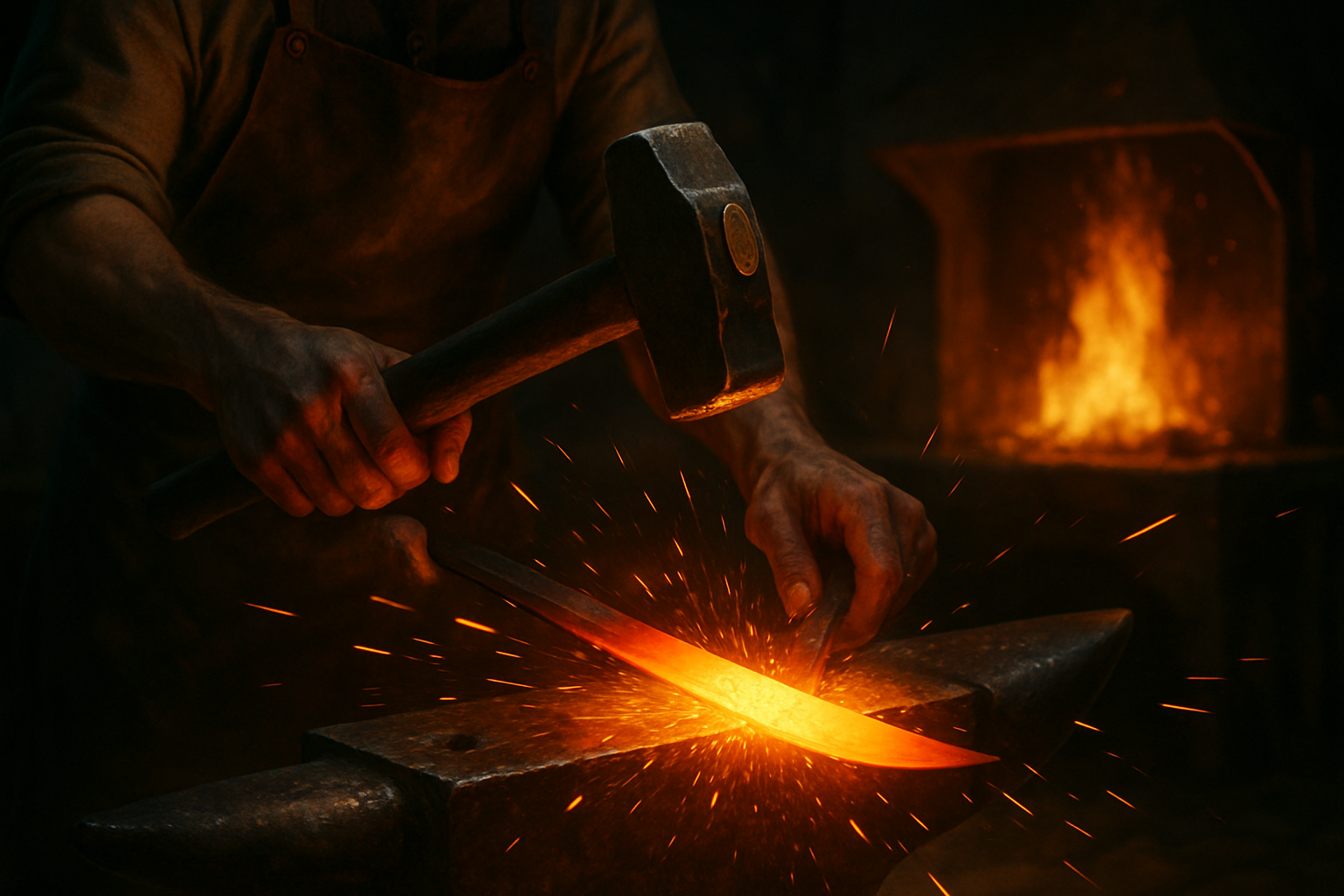The Forge and The Anvil
A personal reflection of how curiosity becomes clarity — mapping Ne/Ti cognition to the craft of creation

Somewhere along the way, I realized my best thinking didn’t happen in isolation. It happens in motion. In conversation. In iteration. Against something — a question, a contradiction, a curious phrase that wouldn’t leave me alone.
This post is about the rhythm of that process. About the way my mind moves from curiosity to clarity, from first heat to finished edge. It’s about how some of us think in sparks and steel. And it's about the cognitive dance of Extraverted Intuition and Introverted Thinking, mapped to the ancient craft of the forge.
Understanding Ne/Ti: The Cognitive Cycle
Ne (Extraverted Intuition) and Ti (Introverted Thinking) are cognitive functions, psychological shorthand for how some of us think and process. They're especially dominant in ENTPs and INTPs, though anyone can tap into them.
Ne is the flame that powers the smelter and forge – it is bright, hot, unpredictable, and always hungry for more fuel. It is a perceptive function, and is how we take in the world. Crucially, it does not sit still. It hunts novelty. It chases possibility. It seeks connections. When you have an idea, and you find yourself possessed by the urge to remix it, twist it, invert it, and apply it in ten different ways, all at once? That's your Ne urge.
Ti is equal parts anvil, quench, and temper. Where Ne looks outward in search of the new, Ti looks inward, seeking truth, coherence, and structure. It is a judging function: internal, analytical, reductionist. It wants clean lines and structural soundness. It doesn’t care if something feels right—it wants to know why it works. Where Ne wants to discover everything, Ti wants to make sense of it all.
Together, they form a loop:
- Ne explores.
- Ti analyzes.
- Ne branches further.
- Ti trims and clarifies.
This loop is generative and iterative, powerful and chaotic. Without structure, it burns out or spirals. When channeled with purpose? That’s where our metaphor begins.
Blacksmithing 101: A Metaphor for Thought
I'm a nerd, so I've watched my fair share of blacksmithing videos on YouTube. I hold no expectations that you've done the same, so if you'll permit me a brief digression, here's the journey from raw ore to finished blade.
- Mine the ore – Find raw material worth working with.
- Smelt and refine – Remove impurities. Combine elements. Discover potential.
- Heat and shape – Repeatedly soften and strike the metal to create form.
- Normalize – Let the metal rest and relieve stress.
- Harden and temper – Make it strong, but not brittle.
- Cool and finish – Sharpen. Polish. Deliver the final product.
It turns out, this isn’t a bad map for how some of us think.
Smelting Ideas
This is the beginning. The curiosity-driven phase.
I start a conversation. I have a wild idea. Something catches my attention — a stray sentence, a passing thought, a strange contradiction. It’s not always clear why it matters yet. I don't always know what I'm looking for, or even that I'm doing it. I'm just looking for interesting rocks, full of potential.
Time to smelt it. I bring it to the workshop. I dump a load of ore into the top of the smelter, apply heat, and melt it down to see what’s inside. The fierce heat of the crucible burns away the impurities and reveals the material's quality. Maybe I add something else — a metaphor, a connection, a deeper question. This is how alloys are formed. And when it's done, a fresh ingot of material sits ready to be shaped.
This whole phase is powered by Ne – it is open-ended, nonlinear, and joyfully chaotic.
The Forge and The Anvil
Now the cycle begins in earnest.
Take that fresh bar from the smelter and put it into the forge. I'm heating the material again, but this time, I'm not looking to melt it, like when I needed to see what it was made of. Now, it's about making it malleable, getting it ready to shape. Pull it from the forge, and as the saying goes, "strike while the iron is hot."
The unsung hero in blacksmithing is the anvil. You can have the best material, best hammer, and best technique in the world – but if you don't have an anvil to work on, you won't get anywhere. The anvil can be whatever you want – mine at the moment happens to be ChatGPT, but it can just as easily be a partner or teammate. Just make sure you pick something that is resilient, structured, and always ready.
Then I begin to shape the metal – the idea – with questions, analogies, counterpoints. Sometimes it's rough hammer blows, sometimes it's a gentle stretching, sometimes it's folding or bending. And all the while, the anvil holds firm. Holds the piece. Absorbs the impact. Reflects what I miss back to me.
The cycle repeats:
- Reheat the idea with more exploration.
- Hammer it with analysis.
- Let it rest.
- Then back to the fire.
Normalization happens in moments of quiet. Sometimes the work needs to stop. Let the idea cool. Step away. Reflect. Come back tomorrow with fresh eyes. In metallurgy, this relieves stress. In cognition, it creates clarity.
This is the feedback loop between Ne and Ti: one sparks, the other refines. Over and over. Repeat as necessary.
Quench and Temper
Eventually, I commit.
The shape is right. The structure holds. It looks good, but it's still not ready. Now we quench the work — test it against logic, edge cases, counterarguments. Does it crack? Does it warp? Does it break entirely?
Examine it further. It may not have broken, but is it good? Does it have strength? Is it resilient? Is the structure sound enough to hold through years of hard use?
If so, temper it. Because perfection is brittle, and usefulness is more important than purity. One final application of heat, but this one is gentlest of all. Not the crucible of the smelter, or the fire of the forge, but rather the warm bath that relaxes and relieves stress.
This is Ti in its clearest form: precise, rigorous, structured. It turns thought into tools. And those tools, when tempered with patience, become something special: an edge that can be honed razor-sharp, that won't chip or break from use.
Show Your Work
Once the blade is forged, tempered, sharpened, and polished, it's time to leave the workshop. It enters the world.
And this is where Fe (Extraverted Feeling) might step in, if you let it. Fe asks:
Will this resonate?
Who needs to hear this?
Is the idea ready to meet another human being?
In practical terms: we publish. We speak. We act. We hand off the tool we’ve made – conceived from the spark of insight, forged from the steel of ideas, shaped through loving craft, and tempered in the warmth of reflection.
And then?
Time to light the fire again.
This piece may be done, but the work is never truly finished.
